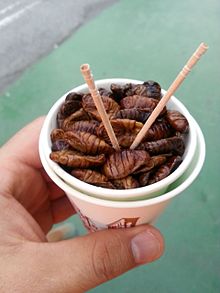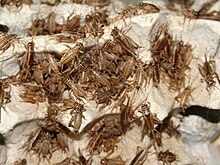

Insects as food or edible insects are insect species used for human consumption. Over 2 billion people are estimated to eat insects on a daily basis. Globally, more than 2,000 insect species are considered edible, though far fewer are discussed for industrialized mass production and regionally authorized for use in food. Many insects are highly nutritious, though nutritional content depends on species and other factors such as diet and age.] Insects offer a wide variety of flavors and are commonly consumed whole or pulverized for use in dishes and processed food products such as burger patties, pasta, or snacks. Like other foods, there can be risks associated with consuming insects, such as allergic reactions. As commercial interest in insects as food grows, countries are introducing new regulatory frameworks to oversee their production, processing, marketing, and consumption.dible insects
Frequently consumed insect species
Human consumption of 2096 different insect species has been documented (2111 if spiders are included).he table below ranks insect order by number and percentage of confirmed species consumed and presents each insect orders' percentage of known insect species diversity. With the exceptions of orders Orthoptera and Diptera, there is close alignment between species diversity and consumption, suggesting that humans tend to eat those insects that are most available.
| Insect order | Common name | Number of confirmed species consumed by humans | Percentage of insect species consumed by humans (%) | Percentage of total insect species (%) |
|---|---|---|---|---|
| Coleoptera | Beetles | 696 | 33 | 38 |
| Lepidoptera | Butterflies, moths | 362 | 17 | 16 |
| Hymenoptera | Bees, wasps, ants | 321 | 15 | 12 |
| Orthoptera | Grasshoppers, locusts, crickets | 278 | 13 | 2 |
| Hemiptera | Cicadas, leafhoppers, planthoppers, scale insects, true bugs | 237 | 11 | 10 |
| Odonata | Dragonflies | 61 | 3 | 1 |
| Blattodea | Termites, cockroaches | 59 | 3 | 1 |
| Diptera | Flies | 37 | 2 | 15 |
| Others | - | 45 | 2 | 6 |
Geography of insect consumption

Insect species consumption varies by region due to differences in environment, ecosystems, and climate. The number of insect species consumed by country is highest in equatorial and sub-tropical regions, a reflection of greater insect abundance and biodiversity observed at lower latitudes and their year-round availability.
For a list of edible insects consumed locally see: List of edible insects by country.
Edible insects for industrialized mass production
To increase consumer interest in Western markets such as Europe and North America, insects have been processed into a non‐recognizable form, such as powders or flour. Policymakers, academics, as well as large-scale insect food producers such as Entomofarms in Canada, Aspire Food Group in the United States, Protifarm and Protix in the Netherlands, and Bühler Group in Switzerland, focus on seven insect species suitable for human consumption as well as industrialized mass production:
- Mealworms (Tenebrio molitor) as larvae
- Lesser mealworms (Alphitobius diaperinus) as larvae, mostly marketed under the term buffalo worms.

Pancakes made from insect powder, served with strawberries and skyr - House cricket (Acheta domesticus)
- Tropical house cricket (Gryllodes sigillatus)
- European migratory locust (Locusta migratoria)
- Black soldier fly (Hermetia illucens)
- Housefly (Musca domestica)
-
Freeze-dried mealworms as food (or food ingredient)
-
House crickets as food (or ingredient)
-
Migratory locusts as food (or ingredient)
Nutritional profile

The nutritional profiles of edible insects are highly variable given the large number of species consumed. In addition to species differences, nutritional content can be affected by geographic origin and production method (wild or farmed), diet, age, development stage, and sex. For instance, female house crickets (Acheta domestica) contain more fat than males, while males contain more protein than females.
Some insects (e.g. crickets, mealworms) are a source of complete protein and provide similar essential amino acid levels as soybeans, though less than casein. They have dietary fiber, essential minerals, vitamins such as B12, riboflavin and vitamin A, and include mostly unsaturated fat.
Locusts contain between 8 and 20 milligrams of iron for every 100 grams of raw locust, whereas beef contains roughly 6 milligrams of iron in the same amount of meat. Crickets are also very efficient in terms of nutrients. For every 100 grams of substance crickets contain 12.9 grams of protein, 121 calories, and 5.5 grams of fat. Beef contains more protein, containing 23.5 grams in 100 grams of substance, but also has roughly triple the calories and four times the amount of fat as crickets do in 100 grams.
| Nutritional value per 100 g |
Mealworms (Tenebrio molitor) |
Buffalo worms (Alphitobius diaperinus) |
House crickets (Acheta domesticus) |
Migratory locust (Locusta migratoria) |
|---|---|---|---|---|
| Energy | 550 kcal / 2303 kJ | 484 kcal / 2027 kJ | 458 kcal / 1918 kJ | 559 kcal / 2341 kJ |
| Fat Of which saturated fatty acids |
37,2 g 9 g |
24,7 g 8 g |
18,5 g 7 g |
38,1 g 13,1 g |
| Carbohydrates Of which sugars |
5,4 g 0 g |
6,7 g 0 g |
0 g 0 g |
1,1 g 0 g |
| Protein | 45,1 g | 56,2 g | 69,1 g | 48,2 g |
| Salt | 0,37 g | 0,38 g | 1,03 g | 0,43 g |
Organoleptic characteristics

The organoleptic characteristics of edible insects vary between species and are influenced by environment. For instance, aquatic edible insects such as water boatmen (family Corixidae) and dragonfly larvae have a fish flavor, while diving beetles taste more like clams. Environment is not always a predictor of flavor, as terrestrial edible insects may also exhibit fish-like flavors (e.g. crickets, grasshoppers). Over 400 volatile compounds responsible for the aroma and flavor of edible insects have been identified. Pheromone chemicals contribute to pungent aromas and flavors in some species and the presence of organic acids (like formic acid in ants) makes some species taste sour. Organoleptic characteristics are dependent on the development stage of the insect (egg, larva, pupa, nymph, or adult) and may change significantly as an insect matures. For example, texture can change from soft to crunchy as an insect develops from larva to adult due to increasing exoskeletal chitin. Cooking method is considered the strongest influence on the final flavor of edible insects. Wet-cooking methods such as scalding or steaming, remove pheromones and odor compounds, resulting in a milder flavor, while dry-cooking methods such as frying and roasting, introduce more complex flavors.
The table below provides common flavor descriptors for a selection of edible insects. Flavors will vary with preparation method (e.g. raw, dried, fried, etc.). Insect development stage is provided when possible.
| Insect | Scientific name | Development stage | Flavor |
|---|---|---|---|
| Agave worm (white) | Aegiale hesperiaris | Larvae | Cracklings |
| Agave worm (red) | Comadia redtenbacheri | Larvae | Spicy |
| Ants | Family Formicidae | Adult | Sweet, nutty |
| Carpenter ant | Camponotus spp. | Adult | Charred lemon |
| Wood ant | Formica spp. | Adult | Kaffir lime |
| Black witch moth | Ascalapha odorata | Larvae | Herring |
| Cockroach | Order Blattodea | - | Mushroom |
| Cricket | Superfamily Grylloidea | Adult | Fish |
| Corn earworm | Helicoverpa zea | Larvae | Sweet corn |
| Dragonfly | Infraorder Anisoptera | Larvae | Fish |
| Grasshopper | Suborder Caelifera | Adult | Fish |
| Honey bee | Apis spp. | Brood | Butter, milk, herbal, vegetal, meaty, mushroom |
| Mealworm | Tenebrio molitor | - | Nutty (larvae); whole wheat bread (adult) |
| Mealybug | Family Pseudococcidae | - | Fried potato |
| Stinkbug | Family Pentatomidae | Adult | Apple |
| Termite | Infraorder Isoptera | Adult | Nutty |
| Treehopper | Family Membracidae | - | Avocado, zucchini |
| Wasp | Suborder Apocrita | - | Pine nut |
| Water boatmen | Family Corixidae | - | Caviar (egg); fish, shrimp (adult) |
Farming, production, and processing


Edible insects are raised as livestock in specialized insect farms. In North American as well as European countries such as the Netherlands or Belgium, insects are produced under strict food law and hygiene standards for human consumption.
Conditions such as temperature, humidity, feed, water sources, and housing, vary depending on the insect species. The insects are raised from eggs to larvae status (mealworms, lesser mealworms) or to their mature form (crickets, locusts) in industrialized insect farms and then killed via temperature control. Culled insects may be freeze-dried and packed whole, or pulverized to insect powder (insect flour) to be used in other food products such as baked goods or snacks.
In addition to nutritional composition and digestibility, insect species are selected for ease of rearing by the producer based on factors such as disease susceptibility, feed conversion efficiency, rate of development, and generational turnover.
Insect food products
The following processed foods are produced in North America (including Canada), and the EU:
- Insect flour: Pulverized, freeze-dried insects (e.g., cricket flour).
- Insect burger: Hamburger patties made from insect powder / insect flour (mainly from mealworms or from house cricket) and other ingredients.
- Insect fitness bars: Protein bars containing insect powder (mostly house crickets).
- Insect pasta: Pasta made of wheat flour, fortified with insect flour (house crickets or mealworms).
- Insect bread (Finnish Sirkkaleipä): Bread baked with insect flour (mostly house crickets).
- Insect snacks: Crisps, flips or small snacks (bites) made with insect powder and other ingredients.
Food and drink companies such as the Australian brewery Bentspoke Brewing Co and the South African startup Gourmet Grubb have introduced insect-based beer, a milk alternative, and insect ice cream.
-
Insect energy bar made with processed crickets
-
Insect snacks (bites) with cultivated cricket flour and oat
Food safety

Like other foods, the consumption of insects presents health risks stemming from biological, toxicological, and allergenic hazards. In general, insects harvested from the wild pose a greater risk than farmed insects, and insects consumed raw pose a greater risk than insects that are cooked before consumption. Feed substrate and growing conditions are the main factors influencing the microbiological and chemical hazards of farmed insects.
The table below combined the data from two studies published in Comprehensive Reviews in Food Science and Food Safety and summarized the potential hazards of the top five insect species consumed by humans.
| Insect order | Common name | Hazard category | Potential hazard |
|---|---|---|---|
| Coleoptera | Beetle | Chemical | Hormones |
| Cyanogenic substances | |||
| Heavy metal contamination | |||
| Lepidoptera | Silkworm | Allergic |
|
| Chemical | Thiaminase | ||
| Honeycomb moth | Microbial | High bacterial count | |
| Chemical | Cyanogenic substances | ||
| Hymenoptera | Ant | Chemical | Antinutritional factors (tannin, phytate) |
| Orthoptera | House cricket | Microbial | High bacterial count |
| Hemiptera |
|
Parasitical | Chagas disease |
| Diptera | Black soldier fly | Parasitical | Myiasis |
The hazards identified in the above table can be controlled in various ways. Allergens can be labelled on the package to avoid consumption by allergy-susceptible consumers. Selective farming can be used to minimize chemical hazards, whereas microbial and parasitical hazards can be controlled by cooking processes.
As a further guarantee for consumers, quality labeling has been introduced by the Entotrust programme, an independent and voluntary product certification of insect-based foods, which allows producers to communicate the safety and sustainability of their activities.
Challenges
There are challenges associated with the production, processing, and consumption of insects as food.
Production
Mass production in the insect industry is a concern due to a lack of technology and funds to efficiently harvest and produce insects. The machinery would have to house proper enclosure for each life cycle of the insect as well as the temperature control as that is key for insect development.
Processing
The availability of wild-harvested insects can be seasonally dependent. This presents a challenge, as many wild-harvested insects have a short shelf life, sometimes of only a day or two. Identifying methods of processing and storing that extend the shelf life of seasonal insects will improve the efficiency of their harvest and consumption.
Regulation and authorisation
EU
In the European Union, edible insects – whole or in parts, e.g., legs, wings, or heads – fall within the definition of novel food, given by the European Commission. Dossiers for several insect species are currently under review by the European Food Safety Authority.
In August 2018, EFSA published a first risk profile for the house cricket as food. According to a risk assessment published by EFSA on 13 January 2021, the yellow mealworm is safe for human consumption. On 2 July 2021, EFSA published another scientific opinion stating that migratory locust in frozen, dried or ground state is safe for human consumption. On 17 August 2021, EFSA published a safety assessment with view to house crickets (Acheta domesticus) stating that frozen and dried formulations from whole house crickets are safe for consumption. On 4 July 2022, EFSA published an opinion confirming the safety of frozen and freeze-dried formulations of the lesser mealworm (Alphitobius diaperinus in larval state) for human consumption.
Following EFSA's assessment, the European Commission has authorized the following edible insects as novel food in the EU:
- Dried Tenebrio molitor larvae (mealworms) with the Commission Implementing Regulation (EU) 2021/882 of 1 June 2021 (in force on 22 June 2021).
- Frozen, dried and powdered forms of migratory locust (Locusta migratoria) with the Commission Implementing Regulation (EU) 2021/1975 of 12 November 2021 (in force on 5 December 2021).
- Frozen, dried and powdered forms of house cricket (Acheta domesticus) with the Commission Implementing Regulation (EU) 2022/188 of 10 February 2022.
- Frozen, paste, dried and powder forms of lesser mealworm larvae (Alphitobius diaperinus) with the Commission Implementing Regulation (EU) 2023/58 of 5 January 2023.
Switzerland
On 1 May 2017, Switzerland approved the following insect species as food:
- House cricket (Acheta domesticus)
- European locust (Locusta migratoria)
- Mealworms (Tenebrio molitor as larvae)
Under certain conditions, these may be offered to consumers whole, pulverized, or processed in food products.
UK
After the Brexit transition period, the regulation regarding edible insects changed in the United Kingdom on 21 January 2021, making them non-marketable without authorization. Insect food products that had been on the market had to be recalled. Insect food products have to be authorized by the Food Standards Agency (FSA) in a novel food authorization process. In February 2022, UK insect industry association Woven Network CIC submitted a first dossier for the authorization of house crickets (Acheta domesticus) as novel food to the FSA.
USA and Canada
In the USA and Canada, insects for human consumption are not classified as novel food and the import and sale is permitted. In the US, insect food products must comply with FDA standards and food labelling regulations (including allergy risk labelling).
Within the Federal Food, Drug, and Cosmetic Act (FD&C Act), the FDA states that "The term 'food' means (1) articles used for food or drink for man or other animals, (2) chewing gum, and (3) articles used for components of any such article." Thus, with insects falling under said category, they must be safe and may not bear any added poisonous or added deleterious substance that is unsafe. Said items may not be prepared, packed, or held under insanitary conditions, and must be produced in accordance with current Good Manufacturing Practice (GMP), regulations for manufacturing/processing, packing, or holding human food. The FD&C Act also includes requirements that pertain to the labeling of food and preventive controls, as applicable. Manufacturers have a responsibility to ensure that the food they produce for the United States market is safe and complies with the FD&C Act and FDA's implementing regulations.
In Canada, insects are subject to the same standards and guidelines as other foods sold in stores or online.
Singapore
Singapore Food Agency (SFA) has approved 16 species of insects, such as crickets, silkworms and grasshoppers, for human consumption in the second half of 2023.
The approval of the insects for consumption will be subject to food safety requirements, including treatment processes to kill pathogens and ensuring that they are packed and stored safely to prevent contamination.





